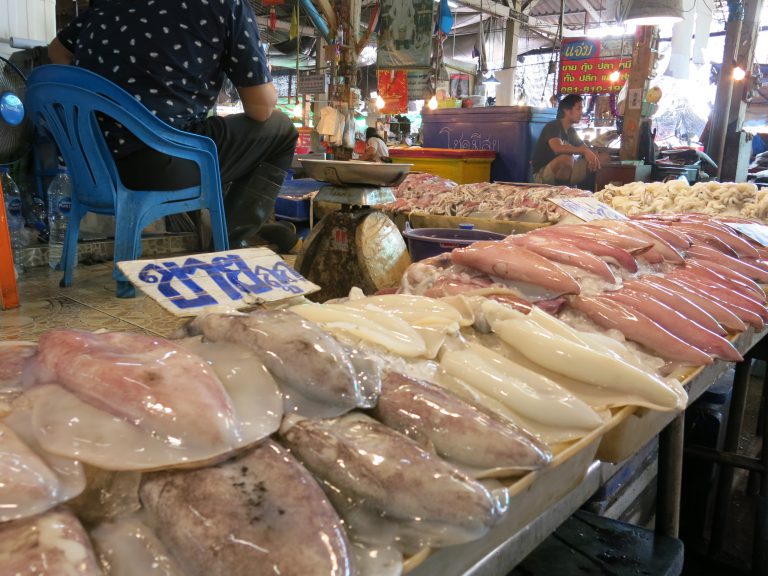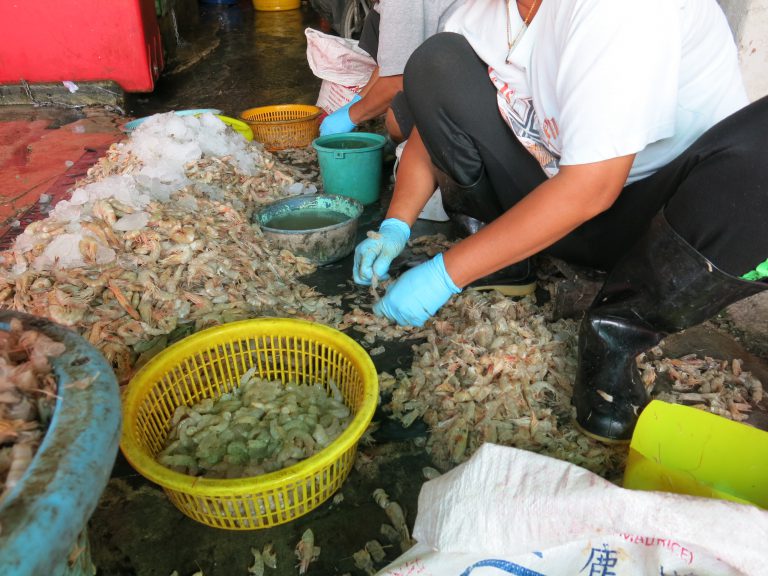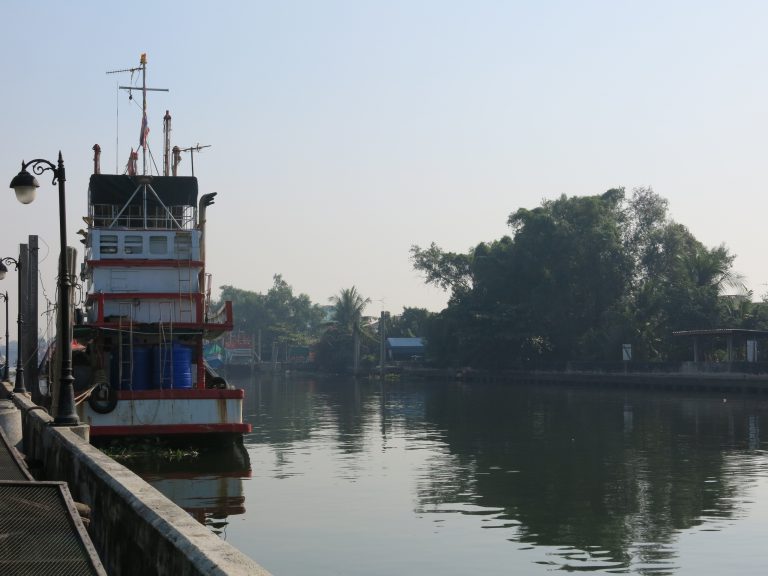By: Dr. Alin Kadfak, Gothenburg University

Seafood market in Thailand. Photo: Alin Kadak
Thanks to globalisation we can enjoy a great variety of seafood from all over the world at a fairly affordable price. But with less fish in the sea to catch, someone has to pay for the misdeeds of unsustainable fishing.
As much as one fifth of fish caught worldwide is Illegal, Unreported and Unregulated. IUU fishing is a great threat to the already exploited marine ecosystem and vulnerable people who depend on fishing for their livelihoods and food security. Furthermore, illegal or pirate fishing is not just about the fish, these practices also often involve changing the vessels’ name or identity to avoid fees, using the flag from states that have less monitoring, bribing authorities to fish in a “no-take” zone and stealing fish from small-scale fishers in the near-shore zone.
The European Union is becoming a major actor in the fight against IUU by using its economic power to pressure other countries to improve the fishing standards, traceability and transparency. However, the fact that many fishing boats with illegal status often recruit unregistered or illegal workers has appeared on the sustainable fish agenda only recently.
Modern slavery exists!
Thailand moved from self-sufficient food production via small-scale fishing in the 1960s, and became the world’s third largest seafood exporter by value. The swiftly growing fishing industry has been constantly in need of labour, and with high physical demand, low pay and long periods out at sea, these jobs are less attractive to Thai. So, migrant fish workers have become a solution for the industry.
The 6.5 billion USD Thai fishing industry came under the spotlight in 2014 when a series of stories by the Guardian exposed how fish workers on Thai fishing boats have been trafficked, abused and had to work in bad working conditions with irregular or no pay at all.

Photo: Alin Kadfak
Why are migrant fishworkers being exploited?
In the last few decades the spread of effective fishing technologies and demand for fish has led to an overexploitation of fish stocks globally. So much that there isn’t enough fish near shores and we have to build ever bigger boats to fish out further in the ocean and for longer periods of time. These conditions combined with the race to optimize the costs and benefits combined with creates a possibility of exploiting the fishworkers on board.
Migrant fishworkers come to Thailand from the neighbouring countries, like Myanmar and Cambodia. First, they illegally get into Thailand with the help of informal brokers who provide loans as a means for travelling to Thai ports. Then migrants have to work on fishing boats to pay-off their loan with high interest. Once they are on board, they have little protection from abusive or unjust practices of boat owners due to their illegal status, for the same reasons many of the migrant workers can’t leave the boats, falling into poverty traps.
Those who come to Thailand legally only have two years working permit per entry. Even though, there are more than 300,000 registered migrant workers working in seafood industry, Thai law does not allow migrant workers to form union. Hence, they have less negotiating power with their employers. In many cases, boat owners keep their documents, like passports and work permit books to eliminate the possibility for workers to change jobs.

Photo: Alin Kadfak
It gets worse before it gets better
Thailand’s fishing industry has been infamous for its poor treatment of migrant workers. But numerous reports of human rights abuse didn’t go unheard and a new approach initiated by the EU in collaboration with the Government of Thailand is an attempt to curb this behaviour. In 2015 the EU issued a yellow card warning indicating possible economic sanctions unless IUU fishing practices are eliminated. This led to several responses by Thai government including radical amendment of fisheries law in 2015.
Currently, the Government of Thailand is closely working with the EU delegation team to improve the situation through regular meetings and joint fieldwork in various ports. And for the first time, Thai government has not only involved the Fisheries Department, but also Ministry of labour, Navy and Ministry of Foreign Affair to look into the issue.
The yellow card warning with economic implications from the EU was a powerful incentive to change. This warning is part of a mechanism to fight against IUU fishing practices developed by the EU over the past decade. Apart from the traceability of where fish is caught, the European Union has included labour rights to bilateral discussions with the Thai government.
Along with the government reforms, a wide range of activities, initiatives and partnerships among environmental organisations and human rights actors was initiated. For instance, the Thai Civil Society’s Coalition for Sustainable and Ethical Seafood (the Thai CSO Coalition) combines the interests of the Association of Thai Fisherfolk Federations with local migrant rights NGOs.
Local and international NGOs started to demand transparency and monitoring of labour rights from Thai seafood companies as well as promote migrant labour welfare. Apart from this initiative, a group of seafood processors, feed producers, buyers, retailers joined hands and formed ‘Seafood Task Force’ to focus on labour and illegal fishing in seafood supply in Thailand.
On 8 January 2019, EU has lifted the yellow card for Thailand. With less international pressure, local and international NGOs continue to ask Thai government to carry on strict implementations to eradicate trafficking practices on Thai fishing boats.
With Thailand being a test case, it remains to be seen whether labour rights will become a formal part of EU’s global approach to sustainable fishing in the future.
What can consumers do?
Not all migrant fish workers are trafficked in Thailand but the framing of the industry as ‘modern slavery’ operation has clearly gained significant attention from governments and consumers alike.
About 70% of fish consumed within EU are fish outside European waters. Sustainable labels tool exists to help consumers know whether the fish they are about to buy comes from a sustainable source. However, a good ethical practice certificate for seafood is yet to be developed.
Consumers’ voices against malpractices in the international seafood industry may at the very least continue to put pressure on governments, NGOs, and inter-governmental forums to carry on with a long-term engagement to cooperate and monitor IUU fishing in seafood exporting countries. One successful example is the “Skippa scampi” campaign by the Swedish NGO Naturskyddsföreningen.
What’s next?
The Thai case provides a blueprint to rethink the way our globalising seafood supply chain operate. Fish and seafood is maybe an international commodity, labour of people is not, as expressed in the preamble of the International Labour Organisation’s founding documents. According to this principle people should not be treated as means of production and, therefore, fish workers, migrant or not deserve to be treated with dignity and respect. Therefore, there is an urgent need to explore further how all the actors involved in the fish industry can cooperate to ensure safe and fair working conditions for the people brining the fish to our tables.
Dr. Alin Kadfak (Gothenburg University), Assoc. Prof. Sebastian Link, (Gothenburg University) and Prof. Than Pale (University of Yangon) will start a new project titled ‘Sustaining fish and fishworkers? Human rights for migrant Burmese fishworkers in the EU-initiated sustainable fisheries reform in Thailand’ in March 2019. This project is funded by Vetenskapsrådet. The team will do fieldwork in Thailand and Myanmar, and conduct interviews in Brussel to try to understand how EU’s fishing policy, as a global governance mechanism, addresses both sustainable fisheries and human rights issues in the case of Thailand.
This blog post was originally published at SIANI.
